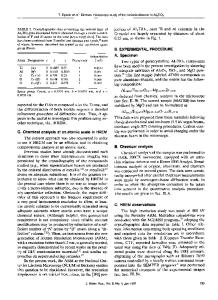Examination of Dislocation Cores in Ni 3 Al Using High Resolution Electron Microscopy
- PDF / 2,138,275 Bytes
- 6 Pages / 420.48 x 639 pts Page_size
- 75 Downloads / 458 Views
EXAMINATION OF DISLOCATION CORES IN Ni 3 AI USING HIGH RESOLUTION ELECTRON MICROSCOPY MARTIN A. CRIMP and P.M. HAZZLEDINE Department of Metallurgy and Science of Materials, University of Oxford, Parks Road, Oxford OXI 3PH, U.K.
ABSTRACT High resolution electron microscopy has been used to study the core structure of a/2[iO1] and a/3 dislocations in Ni 3 AI deformed in the range of increasing strength with temperature. a/3 coupled SISFs were found to lie on (111) and their structure agreed well with theoretical predictions. a/2[i01] superpartials were always dissociated on (111) or (1il) planes while the APB plane was found to be (010). Computer simulation of dislocation core structures were found to agree well with the observed dissociations. The APB width was found to increase significantly with increasing deformation temperature near the peak yield strength temperature.
INTRODUCTION The anomalous yield strength behavior of a number of L1 2 materials is a well known phenomenon and has been investigated by a large number of authors (for review see Pope and Ezz [1]). This behavior has been attributed [2] to thermally activated cross-slip of a/2[i01] screw dislocations from (111) to (010) which occurs due to the lower antiphase boundary energy on the (010) cross slip plane. This model was modified by Takeuchi and Kuramoto [3] to explain the dependence of yield strength on crystallographic orientation and temperature. The most complete model thus far has been presented by Paidar, Pope and Vitek [4] who took into account the splitting of the a/2[i01] into a/6 partials to explain the dependence of the yield strength on both the orientation and the sense of applied stress (tension/compression asymmetry). While this model, known as the PPV model, matched the experimental observations very well [5], there is currently no experimental support for the assumptions of the model. That is that the APB lies on (111), and the superpartial dislocations dissociate onto the (111) or (li) cross slip plane. While there are no experimental observations, a number of authors have performed theoretical calculations of the splitting of the screw superpartial core. The first of these computer simulations was performed by Yamaguchi et al [6] using various empirical interatomic potentials. They found that for an APB lying on the (111) plane, two different core dissociations could occur, one on the (111) plane and one on the (1h1) cross slip plane. These dissociations had nearly the same energy and it was concluded that either could occur. The core structure was found to be one of strongly overlapping partials with no well defined stacking fault. The overall dissociation was found to spread over a small distance of few atomic widths. With the APB lying on the (010) plane, the cores were again found to be dissociated on the {111} planes with similar dissociation modes and magnitudes. Farkas and Savino [7] have repeated this simulation using more exact local volume dependent potentials for Ni3AL. While their simulations arrived at a core struct
Data Loading...











